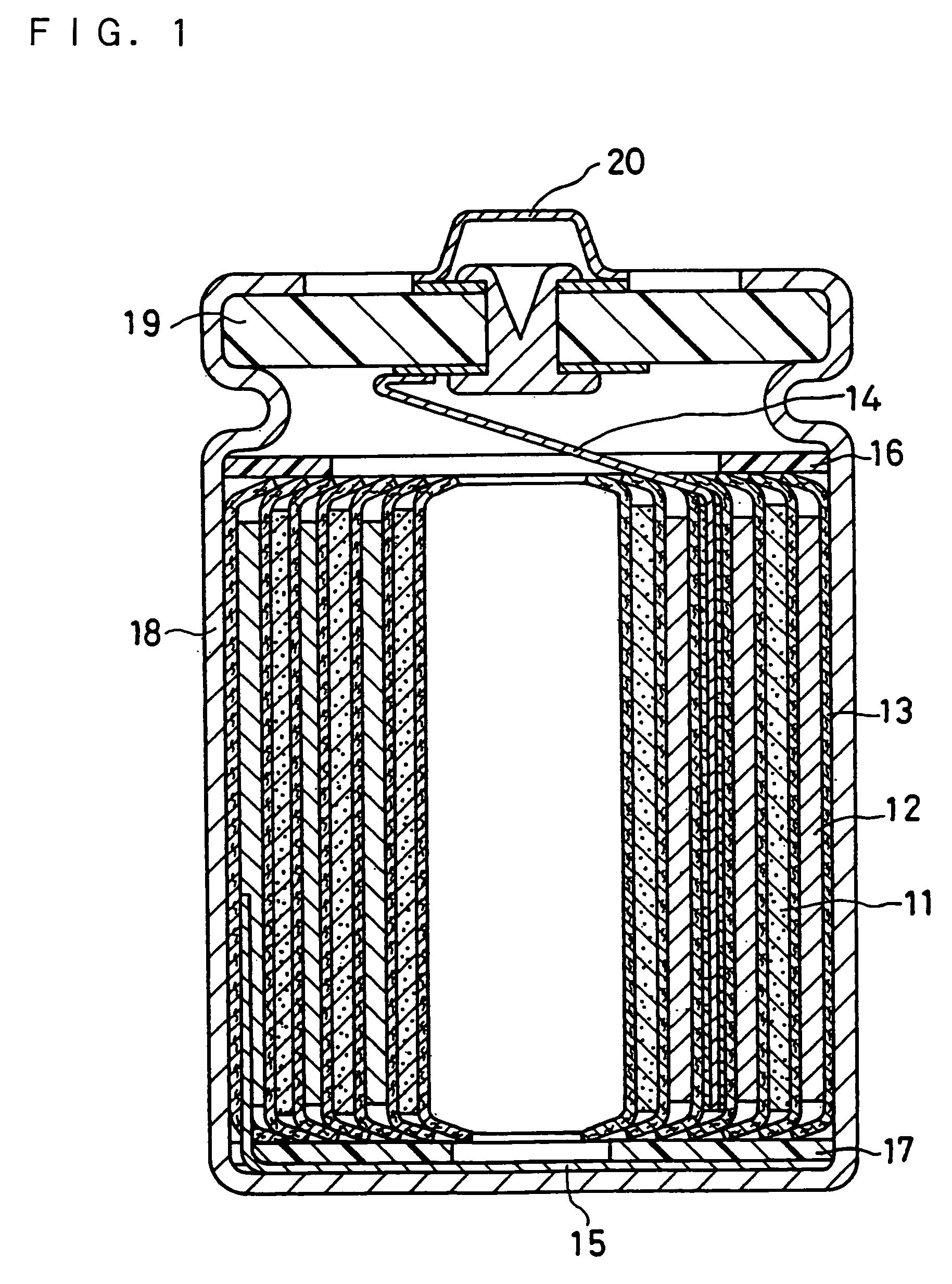Non-aqueous electrolyte secondary battery
a secondary battery, non-aqueous electrolyte technology, applied in the direction of non-aqueous electrolyte cells, cell components, electrochemical generators, etc., can solve the problems of low electron density on the oxygen atom of nio, lower cycle characteristics and thermal safety insufficient cycle characteristics of batteries containing liniosub>2/sub>, etc., to inhibit side reactions, low
- Summary
- Abstract
- Description
- Claims
- Application Information
AI Technical Summary
Benefits of technology
Problems solved by technology
Method used
Image
Examples
example 1
(i) Preparation of Non-Aqueous Electrolyte
[0048]In a solvent mixture of ethylene carbonate (EC) and ethyl methyl carbonate (EMC) at a volume ratio of 1:4 was dissolved LiPF6 at a concentration of 1.0 mol / L. To 100 parts by weight of the obtained solution was added 5 parts by weight of fluorobenzene (FB). Thereby, a non-aqueous electrolyte was prepared.
(ii) Production of Positive Electrode
[0049]A positive electrode material mixture was prepared by mixing 85 parts by weight of LiNi0.8Co0.2O2 powder (positive electrode active material), 10 parts by weight of acetylene black (conductive material) and 5 parts by weight of polyvinylidene fluoride (binder). The positive electrode material mixture was dispersed in dehydrated N-methyl-2-pyrrolidone (NMP) to prepare a positive electrode material mixture slurry. The obtained slurry was applied onto both surfaces of a positive electrode current collector made of an aluminum foil, followed by drying and rolling. Thereby, a positive electrode was...
example 2
[0061]Batteries were produced in the same manner as in EXAMPLE 1 except that nickel-containing lithium composite oxides having compositions shown in Table 2 were used as the positive electrode active material. Then, the produced batteries were evaluated in the same manner as in EXAMPLE 1. The results are shown in Table 2.
[0062]
TABLE 2CapacityPositive electrode activeFluorobenzeneretention ratematerial(part by weight)(%)Ex. 2LiNi0.005Co0.995O2580.2LiNi0.05Co0.95O2580.9LiNi0.1Co0.9O2583.0LiNi0.3Co0.7O2585.1LiNi0.5Co0.5O2585.3LiNi0.7Co0.3O2586.0LiNi0.8Co0.2O2586.5LiNi0.9Co0.1O2586.1LiNiO2581.3LiNi0.8Co0.15Al0.05O2588.2LiNi0.8Co0.15Sr0.05O2587.9LiNi0.8Co0.15Y0.05O2587.5LiNi0.8Co0.15Zr0.05O2587.7LiNi0.8Co0.15Ta0.05O2588.0LiNi0.8Co0.15Mg0.05O2585.2LiNi0.8Co0.15Ti0.05O2585.9LiNi0.8Co0.15Zn0.05O2586.1LiNi0.8Co0.15B0.05O2586.1LiNi0.8Co0.15Ca0.05O2584.6LiNi0.8Co0.15Cr0.05O2585.5LiNi0.8Co0.15Si0.05O2584.4LiNi0.8Co0.15Ga0.05O2586.0LiNi0.8Co0.15Sn0.05O2585.8LiNi0.8Co0.15P0.05O2584.7LiNi0.8Co0.15...
example 3
[0066]Batteries were produced in the same manner as in EXAMPLE 1 except that compounds shown in Table 3 were used as the fluorine atom-containing aromatic compound contained in the non-aqueous electrolyte. Then, the produced batteries were evaluated in the same manner as in EXAMPLE 1. The results are shown in Table 3.
[0067]
TABLE 3Fluorine atom-containing aromaticCapacity retentioncompoundrate(%)Ex. 3Fluorobenzene86.51,2-difluorobenzene85.11,2,3-trifluorobenzene85.01,2,3,4-tetrafluorobenzene84.8Pentafluorobenzene84.5Hexafluorobenzene84.22-fluorotoluene82.7α,α,α,-trifluorotoluene80.33-fluoro-o-xylene81.4Bistrifluoromethylbenzene80.82-fluorostyrene82.24-fluorostyrene82.9
[0068]As can be seen from Table 3, regardless of the type of the fluorine atom-containing aromatic compound, the combined use of a positive electrode active material comprising the nickel-containing lithium composite oxide and a non-aqueous electrolyte containing the fluorine atom-containing aromatic compound can yield ...
PUM
| Property | Measurement | Unit |
|---|---|---|
| thickness | aaaaa | aaaaa |
| thickness | aaaaa | aaaaa |
| voltage | aaaaa | aaaaa |
Abstract
Description
Claims
Application Information
 Login to View More
Login to View More - R&D
- Intellectual Property
- Life Sciences
- Materials
- Tech Scout
- Unparalleled Data Quality
- Higher Quality Content
- 60% Fewer Hallucinations
Browse by: Latest US Patents, China's latest patents, Technical Efficacy Thesaurus, Application Domain, Technology Topic, Popular Technical Reports.
© 2025 PatSnap. All rights reserved.Legal|Privacy policy|Modern Slavery Act Transparency Statement|Sitemap|About US| Contact US: help@patsnap.com



